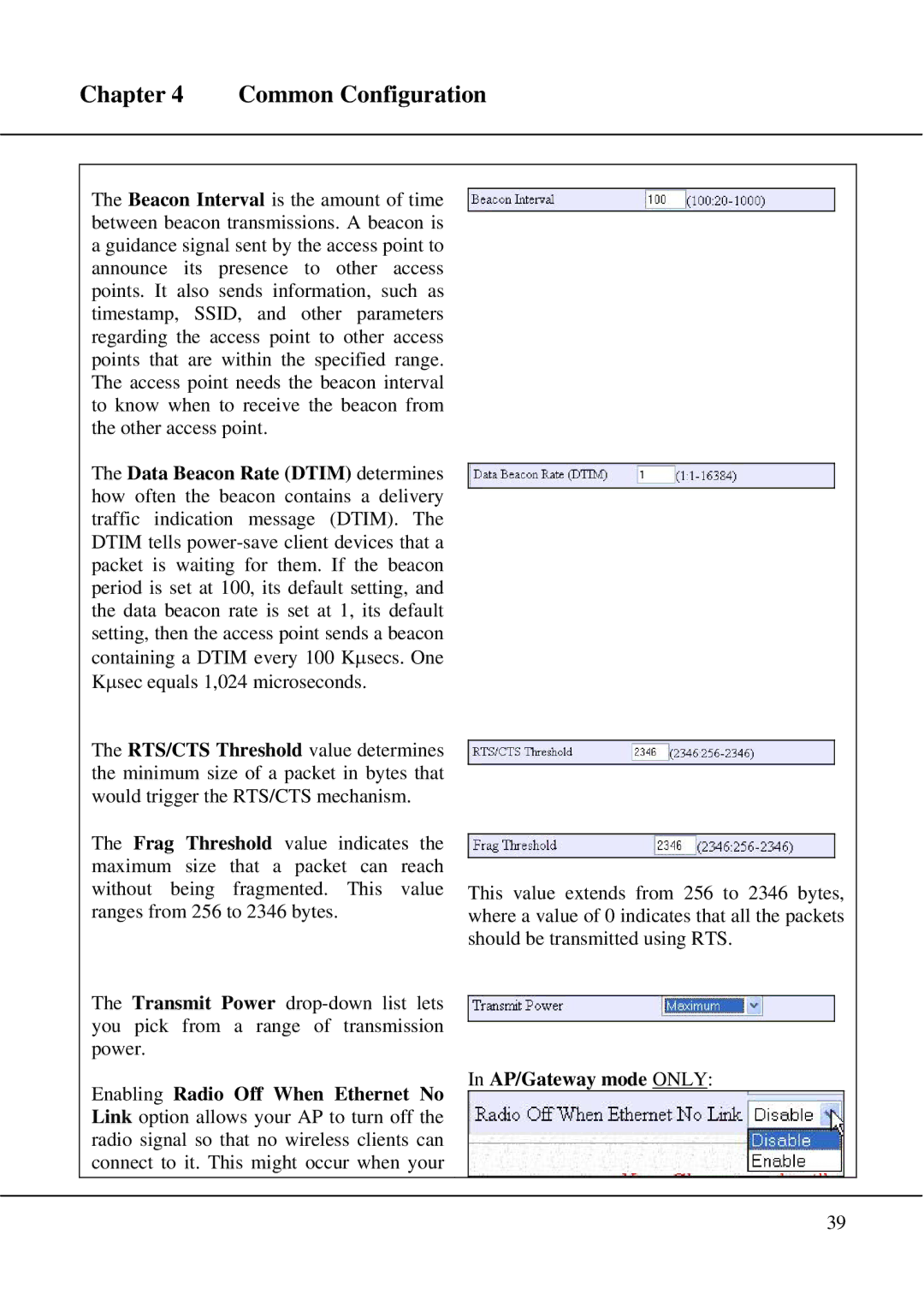Page
Disclaimer
Trademark Information
Your Feedback
FCC Notice
Declaration of Conformity
Technical Support Information
Compex, Inc
How to Use this Document
About This Document
Firmware
Conventions
Chapter Hardware Installation
Chapter Further Configuration
Appendix Troubleshooting 118
Features and Benefits
Hardware Installation Product Overview
Introduction
Hardware Installation
When to use which mode
STP
Access Point Mode
Access Point Client Mode
Static IP address
Gateway Mode
Dynamic IP address
Singapore Adsl Ethernet 512K
PPP over Ethernet PPPoE
Australia BPA Cable
Wireless Routing Client Mode
Wireless Ethernet Adapter Mode
Wireless Bridge Link Mode
Setup Requirements
Hardware Installation
Access to the Web interface with uConfig
Access to Web-based Interface
Through our Utility uConfig
Access to Web-based Interface
Access to Web-based Interface
Direct access to web-based interface via Internet Explorer
Access to Web-based Interface
Access to Web-based Interface
Access to Web-based Interface
Common Configuration
Management Port Setup
Management Port Wlan Basic Setup Wlan Security STP Setup
Setting up your LAN
Parameters
Description
Common Configuration
View Active Dhcp Leases
To view the active Dhcp leases
Go to the Advanced Dhcp Server
Reserve Specific IP addresses
Common Configuration
Delete Dhcp Server Reservation
Wlan Setup
Basic
Security
Advanced
To configure the Basic setup of the wireless mode
Basic Setup Wireless Mode
Common Configuration
Common Configuration
Advanced Setup Wireless Mode
To configure the Advanced setup of the wireless mode
Wlan Advanced Setup
AP/Gateway mode only
Common Configuration
Scan for Site Survey
Scan For Site Survey
Ssid
Show Link Information
Show Link Information
Link Information section
Link Information table illustrates the following data
Features Mode
Wireless Extended Features
Access Control The Wireless Pseudo Vlan
Wireless Pseudo Vlan Per Node
Wireless Pseudo Vlan Per Node
Wireless Pseudo Vlan Per Group
Wireless Pseudo Vlan Per Group
Common Configuration
Delete client from a group
Wireless Pseudo Vlan Tag Vlan
Tag Vlan
Common Configuration
Delete client from a Tag Vlan
Wireless Setup The Wireless Distributed System WDS
Star Configuration WDS
Chain Configuration WDS
WDS Configuration Setup
At the Edit WDS Link page which shows
Click on the Back button to return to the WDS Status
Common Configuration
WMM Parameters
WMM Parameters
WMM Parameters for advanced users
Long Distance Parameters available in all modes
Long Distance Parameters
ACK Timeout
CTS Timeout
Outdoor
Distance
Security Mode is set to
Selecting Security Mode
Wlan Security
Security Mode -WEP
How to set up WEP Available in ALL modes
When using 64-bit encryption
When using 128-bit encryption
Further Configuration
How to set up WPA-PSK
Security Mode -WPA-PSK, WPA2-PSK, WPA-PSK-AUTO
At the Wlan Security Setup
Further Configuration
Security Mode -802.1x/RADIUS
Radius Server, if any
How to set up WPA EAP
Security Mode WPA-EAP, WPA2-EAP, WPA-EAP-AUTO
Further Configuration
STP Setup
Further Configuration
Further Configuration
Bandwidth STP Cost
Scenario #1 No STP, No Pseudo Vlan
Scenario #2 With STP, No Pseudo Vlan
Scenario #3 With STP and Pseudo Vlan
Enabling STP Setup
Forwarding Delay
Priority
Hello Time
MAC Filtering
Snmp Setup
Enabling Snmp
Enabling MAC Filtering
Setting up uConfig
UConfig Set up
Click on WAN Setup from the Configuration menu
Configuring WAN Setup
Changing WAN Type
At the Dynamic IP WAN Setup
Changing WAN Type Dynamic IP Configuration
Dynamic IP
At the Static IP WAN Setup
Changing WAN Type Static IP Configuration
Static IP
At the PPPoE WAN Setup
Changing WAN Type PPPoE Configuration
PPPoE
Chapter Further Configuration
PPPoE Parameter Description
At the Singapore Adsl WAN Setup
Changing WAN Type Singapore Adsl Configuration
Singapore Adsl
At the Australia BPA WAN Setup
At the Pptp WAN Setup
Changing WAN Type Pptp Configuration
Pptp
Enabling NAT
Setting up DMZ
To set up a De-Militarised Zone host
Disable DMZ
To set up port forwarding
Set up Port Forwarding For Known Server
Address field
Set up Port Forwarding For Custom Server
Delete a table entry
Application Port Number
Routing
Static Routing
Static Routing
Specify the Destination IP
Delete Static Routing
Dynamic Routing
By default, Dynamic Routing is disabled
Dynamic Routing
TCP Port
Source IP Address
Time frame
Click on IP Filtering from the Configuration menu
IP Filtering
At the Destination Port drop down list, select either
Further Configuration
Filtering Configuration table will then be refreshed
Delete IP Filtering
Remote Management
Remote Management feature
Port and the Telnet Port
Enabling Parallel Broadband Only available in Gateway mode
Load balancing
Fail-Over Redundancy
Enable Parallel Broadband
To enable Parallel Broadband
Click on Parallel Broadband from the Configuration menu
Using the System Tools Menu
System Utilities
System Tools menu
System Identity
Wlan Station List
Wlan Station List
Click on Wlan Station List from the System Tools menu
Set System’s Clock
Set System’s Clock
Click on Set System’s Clock from the System Tools menu
Time Zone for the system
Firmware Upgrade
Firmware Upgrade
Click on Firmware Upgrade from the System Tools menu
Upgrade Firmware path and file name field
Save Your Settings
Backup Your Settings
Restore Your Settings
Reset Your Settings to Factory Default
Reboot Your device
Reboot System
Click on Reboot System from the System Tools menu
Change Password
Changing your Password
Logout
Get Technical Support
Using the Help menu Get Technical Support
Click on Get Technical Support from the Help menu
About System
Appendix I Troubleshooting
AI Solutions to Common Problems
Am not able to access the Web interface of the access point
For Netscape 4.7 or later versions
Want to set the access point to its factory default settings
My laptop is not able to access the AP
Appendix I Troubleshooting
Operation State
Diag LED
Appendix III TCP/IP Configuration
AIII.1 Configure dynamic IP Address in Windows 98SE/ME
124
Appendix III TCP/IP Configuration
Appendix III TCP/IP Configuration
AIII.2 Configure dynamic IP Address in Windows XP/2000
Appendix III TCP/IP Configuration
AIII.3 Configure static IP Address in Windows 98SE/ME
AIII.4 Configure static IP Address in Windows XP/2000
Features Status and Indications
Appendix Panel Views and Descriptions
Appendix IV Panel Views and Descriptions
Appendix Technical Specifications
WPA1/2-PSK / WPA1/2-EAP
Snmp
Appendix V Technical Specifications
CE R&TTE
Manual Number 0428-V1.4C Version May Cxxxvi

